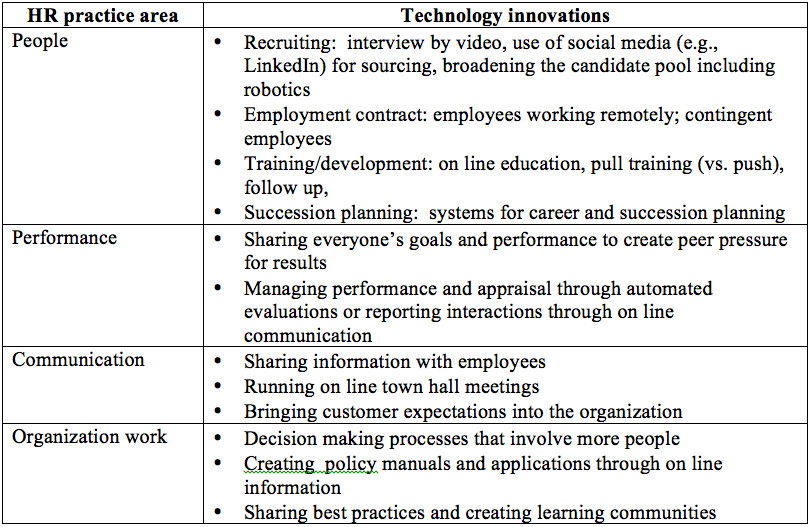Do An HR Technology Audit To Get The Most Out Of Digital HR

Do An HR Technology Audit To Get The Most Out Of Digital HR

No one doubts that technology has changed our lives. Global online sales have doubled in five years to over $1.5 trillion. The Big Six social networks (Facebook, Twitter, LinkedIn, Instagram, Google+, and Pinterest) exceed 2.4 billion people. The largest of which, Facebook, would be the second most populous country on the planet, after China. Technology pervades our daily lives in how we use computers, communicate, access entertainment, drive, shop, form relationships, and so forth. Unprecedented and fast innovation in technology increases access, shares information, and removes boundaries.
So, what are the implications for HR?
The digital world of HR is a major theme for dozens of HR conferences and new applications and tools with great promise. We have distilled the divergence of HR technology work into four phases to assess your HR technology focus and investment.
Phase 1: to what extent do we use technology to streamline administrative HR work?
Large global firms like Oracle (with PeopleSoft), SAP (with Success Factors), and Workday (with Workday Human Capital Management) offer technology platform services, engineered systems and software applications for business and HR solutions. These firms often build the backbone for shared services where work is done faster, cheaper, and easier. Emerging robots extends this efficiency agenda.
Phase 2: to what extent do we use technology to innovate our HR practices?
Every HR practice area is being upgraded through technology. These upgrades drive HR innovations as illustrated below:

Phase 3: to what extent do we use technology to access information?
We found in our research (see forthcoming book Victory Through Organization) that information management is the most critical capability to deliver business results. Access to information traditionally gives leaders power because they have more information than their employees. Today, with open access of information through technology, information is less about power and more about the ability to make better business decisions. HR departments can influence information capability in a number of ways.
First, HR will play a role in building information capability in their organization by hiring information experts. Sixty percent of occupations could have up to 30% of their activities automated including radiologists, design engineers, market researchers and HR professionals. They are being replaced by big data analysts, social media experts, cloud builders, app developers, and other types of information specialists. Software engineering jobs will grow at a rate of 18.8% by 2024 which is triple the rate of overall job growth rate. HR can help source and secure this talent.
Second, HR can ensure that external information comes into an organization to inform decisions. HR analytics is not just about using information to improve HR practices (see Phase 2 above with HR scorecards and HR insights) and more about accessing information to make better business decisions. In this regard, HR can be the architect of prioritizing key business decisions, then sourcing information both outside and inside the organization to improve those decisions.
Third, information that delivers business results may be structured information that is found on a spreadsheet and accessed through statistics or it may be unstructured information that is found in customer and employee experiences and accessed through thoughtful observation.
Phase 4: to what extent do we use technology to create social experiences and connections?
Recent research has found that social isolation increases mortality more than smoking, obesity, or substance abuse. HR can use technology to build connections among people that create positive social experiences. Employees are often looking less for a job or even a career, and more for an experience that will increase their personal identity and well being.
While most technology based social connections either begin with or include face to face and personal interactions, the technology enhance connections. These connections may be problem solving networks where people work on common business problems with others from around the world, social networks where people share their daily lives, or meaning networks where people connect with others who share their values.
For the millennial generation, these technology enabled networks are often a major part of daily lives. For all generations, technology networks need to shift from sharing information to also creating emotional connections. Gamification, for example, is not just about using games to share information, but to build personal relationships among the game players.
To test for this emotional and social connection, HR professionals can evaluate the extent to which bids among network members are positive responded to. A bid is an offer to connect. In enduring relationships, 80% of bids are positively responded to. Will those in a technology network respond to personal bids from its members? In other words, do members of a technology enabled network care for the well being of each other beyond the information they share.
Currently, in most firms, technology is used to (phase 1) deliver administrative efficiency, (phase 2) upgrade and innovate HR practices, and (phase 3) deliver information. Increasingly, technology should encourage social and emotional connections among employees inside an organization and among employees and stakeholders outside an organization (phase 4).
So, take time to evaluate your HR department against these four phases to get the most out of digital HR.
- - - -
To learn more about The RBL Group's Strategic HR Assessments, please click here.
No one doubts that technology has changed our lives. Global online sales have doubled in five years to over $1.5 trillion. The Big Six social networks (Facebook, Twitter, LinkedIn, Instagram, Google+, and Pinterest) exceed 2.4 billion people. The largest of which, Facebook, would be the second most populous country on the planet, after China. Technology pervades our daily lives in how we use computers, communicate, access entertainment, drive, shop, form relationships, and so forth. Unprecedented and fast innovation in technology increases access, shares information, and removes boundaries.
So, what are the implications for HR?
The digital world of HR is a major theme for dozens of HR conferences and new applications and tools with great promise. We have distilled the divergence of HR technology work into four phases to assess your HR technology focus and investment.
Phase 1: to what extent do we use technology to streamline administrative HR work?
Large global firms like Oracle (with PeopleSoft), SAP (with Success Factors), and Workday (with Workday Human Capital Management) offer technology platform services, engineered systems and software applications for business and HR solutions. These firms often build the backbone for shared services where work is done faster, cheaper, and easier. Emerging robots extends this efficiency agenda.
Phase 2: to what extent do we use technology to innovate our HR practices?
Every HR practice area is being upgraded through technology. These upgrades drive HR innovations as illustrated below:

Phase 3: to what extent do we use technology to access information?
We found in our research (see forthcoming book Victory Through Organization) that information management is the most critical capability to deliver business results. Access to information traditionally gives leaders power because they have more information than their employees. Today, with open access of information through technology, information is less about power and more about the ability to make better business decisions. HR departments can influence information capability in a number of ways.
First, HR will play a role in building information capability in their organization by hiring information experts. Sixty percent of occupations could have up to 30% of their activities automated including radiologists, design engineers, market researchers and HR professionals. They are being replaced by big data analysts, social media experts, cloud builders, app developers, and other types of information specialists. Software engineering jobs will grow at a rate of 18.8% by 2024 which is triple the rate of overall job growth rate. HR can help source and secure this talent.
Second, HR can ensure that external information comes into an organization to inform decisions. HR analytics is not just about using information to improve HR practices (see Phase 2 above with HR scorecards and HR insights) and more about accessing information to make better business decisions. In this regard, HR can be the architect of prioritizing key business decisions, then sourcing information both outside and inside the organization to improve those decisions.
Third, information that delivers business results may be structured information that is found on a spreadsheet and accessed through statistics or it may be unstructured information that is found in customer and employee experiences and accessed through thoughtful observation.
Phase 4: to what extent do we use technology to create social experiences and connections?
Recent research has found that social isolation increases mortality more than smoking, obesity, or substance abuse. HR can use technology to build connections among people that create positive social experiences. Employees are often looking less for a job or even a career, and more for an experience that will increase their personal identity and well being.
While most technology based social connections either begin with or include face to face and personal interactions, the technology enhance connections. These connections may be problem solving networks where people work on common business problems with others from around the world, social networks where people share their daily lives, or meaning networks where people connect with others who share their values.
For the millennial generation, these technology enabled networks are often a major part of daily lives. For all generations, technology networks need to shift from sharing information to also creating emotional connections. Gamification, for example, is not just about using games to share information, but to build personal relationships among the game players.
To test for this emotional and social connection, HR professionals can evaluate the extent to which bids among network members are positive responded to. A bid is an offer to connect. In enduring relationships, 80% of bids are positively responded to. Will those in a technology network respond to personal bids from its members? In other words, do members of a technology enabled network care for the well being of each other beyond the information they share.
Currently, in most firms, technology is used to (phase 1) deliver administrative efficiency, (phase 2) upgrade and innovate HR practices, and (phase 3) deliver information. Increasingly, technology should encourage social and emotional connections among employees inside an organization and among employees and stakeholders outside an organization (phase 4).
So, take time to evaluate your HR department against these four phases to get the most out of digital HR.
- - - -
To learn more about The RBL Group's Strategic HR Assessments, please click here.


